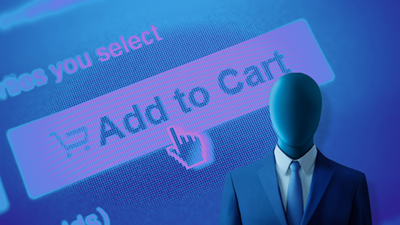Understanding the Impact of Headless Commerce on E-commerce Strategy


In the hyper-competitive online retail arena, personalization isn't just a buzzword—it's the difference between visibility and obscurity. A recent McKinsey study reveals that 71% of consumers expect tailored interactions, with 76% expressing frustration with generic experiences. The ability to craft bespoke shopping journeys has become the ultimate differentiator—the secret sauce to turning casual browsers into buyers.
Enter headless commerce, an architectural approach that decouples front-end presentation from back-end functionality. This innovative strategy addresses the demand for tailored e-commerce experiences across various digital touchpoints. While traditional e-commerce platforms often struggle to meet modern personalization needs, headless commerce offers a solution by providing the flexibility and agility to create unique, personalized shopping journeys.
In this article, we'll explore how headless commerce addresses personalization challenges, its key advantages, and its potential to reshape the e-commerce landscape.
What is Headless Commerce?
Definition and Concept
Headless commerce is an e-commerce architecture that separates the front-end presentation layer from the back-end e-commerce functionality. In this model, the "head" (the front end) is decoupled from the “body” (the back end), allowing each to operate independently while communicating via APIs.
How Headless Commerce Differs from Traditional E-commerce
Traditional e-commerce platforms typically have a tightly coupled front-end and back-end. This monolithic architecture often struggles with evolving consumer preferences and emerging technologies. In contrast, headless commerce allows for greater agility and customization.
Overview of the Architecture
Think of headless commerce as a modular smart home. The central hub (back-end) manages all the core functions, while various front-end interfaces—smartphone app, voice assistant, wall panel, etc.—can be customized to suit user preferences without altering the underlying system.
The Personalization Imperative
The appetite for personalization is voracious and growing. Industry analysts forecast that the global AI-based personalization market will grow at a CAGR of 20.45% between 2022 and 2027, underlining the economic imperative driving this trend. This surge reflects a fundamental shift in consumer expectations and a market where generic experiences are no longer sufficient to capture and retain customer attention.
McKinsey's research further emphasizes this point, showing that companies that excel at personalization generate 40% more revenue than average players. Across US industries, shifting to top-quartile performance in personalization would generate over $1 trillion in value.
Current Challenges
Despite the clear demand, current personalization strategies often fall short:
- Only one in five consumers say they feel valued by brands
- A mere 5% receive a well-timed, relevant email offer
The challenge? Emulating a great store associate experience across omnichannel customer journeys requires deep, actionable customer insights.
Traditional e-commerce platforms, with their tightly coupled front end and back end, struggle to keep pace with both the evolving landscape of consumer preferences and the ever-shifting winds of emerging technologies. These platforms often lack the flexibility to integrate advanced AI and analytics tools, making it difficult to deliver truly personalized experiences.
Moreover, the cost of poor personalization is significant. According to a study by Accenture, 41% of consumers switched companies due to poor personalization, resulting in an estimated $756 billion loss in retail and consumer goods sales.
The Headless Solution
Headless commerce addresses this disconnect by enabling businesses to collect and leverage customer data across all touchpoints. By providing a flexible, scalable foundation for integrating advanced analytics and AI, headless solutions empower brands to deliver the hyper-personalized experiences modern consumers crave, bridging the gap between personalization ambitions and reality.
The Headless Advantage: Benefits of Headless Commerce
1. Omnichannel Ubiquity
Forrester reports that an average person switches between three devices to complete a task, and 70% are more willing to purchase more from brands that excel across multiple channels. Yet, many businesses are still lagging in omnichannel personalization—a gap that headless commerce is well-positioned to bridge.
2. Content Flexibility
This flexibility extends beyond product recommendations. With headless commerce, businesses can:
- Tailor landing pages based on user location, browsing history, or customer segment.
- Dynamically adjust product descriptions to highlight features most relevant to each user.
- Personalize email content in real-time, even after the email has been sent.
- Adapt content across various devices and platforms without recreating it for each channel.
- Implement A/B testing more efficiently, allowing for rapid iteration and optimization of content.
3. AI-Driven Recommendations
AI-driven product recommendations have become a cornerstone of modern e-commerce, enhancing customer experiences and driving sales.
Here are some notable examples:
- Amazon: Leverages machine learning to analyze user behaviors, providing highly personalized and targeted product suggestions.
- Stitch Fix: Uses AI to analyze user feedback and styling preferences, delivering tailored fashion choices.
- Salesforce: Offers AI-powered product recommendations and intelligent merchandising tools, helping enhance shopper experiences and drive growth.
These examples illustrate how AI-driven recommendations can significantly improve personalization, customer engagement, and sales in e-commerce.
4. Rapid Experimentation
Quick testing and refinement of personalization strategies through efficient A/B testing.
5. Future-Proofing and Scalability
Swift adaptation to emerging technologies like AR and voice commerce.
Implementing Headless Commerce in Your E-commerce Strategy

Transitioning to headless commerce requires careful planning and execution. Here's a step-by-step guide to help you implement this approach effectively:
- Assess Your Business Needs and Goals:
- Evaluate your current e-commerce infrastructure and identify personalization gaps.
- Define clear objectives for your headless commerce implementation, such as improving site speed, enhancing personalization, or expanding to new channels.
- Conduct a cost-benefit analysis to ensure the transition aligns with your business strategy.
- Choose the Right Headless CMS and E-commerce Platform:
- Research platforms that align with your business needs, such as Commercetools, BigCommerce, or Shopify Plus.
- Consider factors like scalability, API capabilities, developer resources, and integration options with your existing systems.
- Evaluate the platforms' support for personalization features and AI integration.
- Develop a Robust API Strategy:
- Design a comprehensive API architecture that allows seamless communication between your front-end and back-end systems.
- Implement API gateways to manage, secure, and monitor your APIs effectively.
- Consider adopting a microservices architecture for greater flexibility and scalability.
- Ensure Seamless Collaboration:
- Foster close collaboration between front-end, back-end, and data science teams.
- Implement agile methodologies to facilitate rapid iteration and continuous improvement.
- Invest in training to ensure your teams can work effectively in a headless environment.
- Plan for Data Management and Integration:
- Develop a strategy for centralizing and managing customer data across all touchpoints.
- Ensure your data architecture supports real-time personalization and analytics.
- Plan for integrations with other systems like CRM, ERP, and marketing automation tools.
- Implement Gradually:
- Consider a phased approach, starting with a single channel or product line.
- Use A/B testing to compare performance between your traditional and headless setups.
- Gather feedback and iterate on your implementation before full-scale rollout.
By following these steps, you can navigate the complexities of implementing headless commerce and set your business up for success in delivering personalized omnichannel experiences.
Enhancing Customer Experience with Headless Commerce
Leverage the flexibility of headless commerce to deliver truly personalized experiences:
- Tailor product recommendations based on real-time browsing behavior and historical data
- Dynamically adjust content, layouts, and messaging to match individual user profiles
- Implement personalized pricing and promotions
- Create consistent, personalized experiences across all channels
- Explore cutting-edge technologies like Progressive Web Apps (PWAs) and augmented reality (AR) for advanced personalization
Market Dynamics and Global Adoption

According to a report by Major Digital, the headless commerce market is experiencing exponential growth and is projected to surpass $13.08 billion by 2028—a staggering 30.1% CAGR.
Adoption rates, however, vary globally:
- North America and Western Europe lead the charge
- Asia-Pacific is rapidly catching up
- China sees a surge, driven by its mobile-first consumer base and tech-savvy millennials
Economic Ripple Effects
This technological shift is reshaping the job market. "Headless Commerce Developer" is now a coveted title, with salaries ranging from $56,000 to $126,000 annually. The demand for skills in API development, front-end frameworks, and cloud technologies is soaring. In the world of e-commerce, losing one's head might be the smartest career move.
Major retailers are also reaping the benefits:
Cineplex, a Canadian Cinema chain, implemented a headless solution to integrate multiple web properties following a merger. The solution allowed frequent updates to be refreshed throughout Cineplex's back-end system and significantly expanded its online sales, ticketing, and movie search functionality.
Indeed, McKinsey indicates that brands that capture more value in their personalized web experiences can increase sales and are likely to grow faster.
Environmental Benefits
Interestingly, headless commerce may have an unexpected beneficiary: the environment. The decoupled architecture can lead to reduced server loads and more efficient resource utilization. While the impact is yet to be quantified, it's promising for eco-conscious consumers and businesses.
Challenges and Considerations in Adopting Headless Commerce
Implementation Costs: Despite its advantages, headless commerce is not without hurdles. The increased complexity can lead to higher implementation and maintenance costs, potentially making it unattainable for small businesses.
Security Concerns: Security also needs consideration, with an increased reliance on APIs introducing new vulnerabilities. It's a bit like adopting a high-maintenance pet—it's cutting-edge and impressive, and the rewards are significant, but you'll need to factor in the costs required to keep it fed and happy.
Privacy Considerations: As data privacy concerns grow, businesses must navigate the delicate balance between personalization and privacy. The rise of cookieless personalization and the increasing use of first-party data are trends that headless commerce platforms will need to adapt to in the coming years.
The Road Ahead: Future Trends in Headless Commerce
Emerging trends include:
- AI-driven personalization
- Voice-enabled shopping
- Augmented reality experiences
- Blockchain technologies for enhanced security
- Anonymous visitor personalization
Conclusion
Headless commerce represents a paradigm shift in e-commerce, offering unparalleled flexibility, seamless omnichannel experiences, and powerful personalization capabilities. As we move into the future, businesses that harness the power of headless commerce to deliver personalized, seamless, and innovative shopping experiences will thrive.
Now is the time to explore headless commerce options for businesses looking to stay competitive in the rapidly evolving e-commerce landscape. By taking the first steps towards implementation, you can position your business at the forefront of personalized shopping experiences, driving customer loyalty and revenue growth in the years to come.

About the Author
Adam is an experienced marketing leader with a natural curiosity about human behaviour. He heads up Agility's marketing efforts, helping others discover and experience the easy to use CMS with insane support. A big believer of living in the moment, Adam doesn't want to see you wasting the precious time you have on this earth on clunky, outdated content management systems. He's been there. It wasn't pretty. Give Agility CMS a try and start enjoying your life while you rock your job and have less headaches. Learn more about Adam HERE
